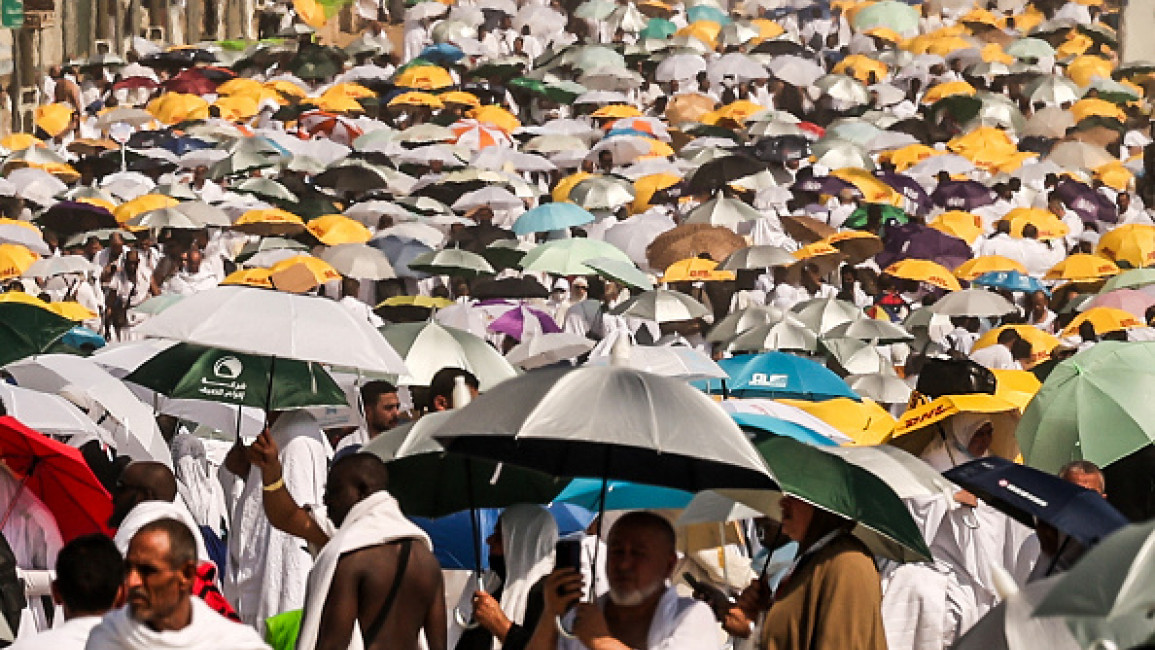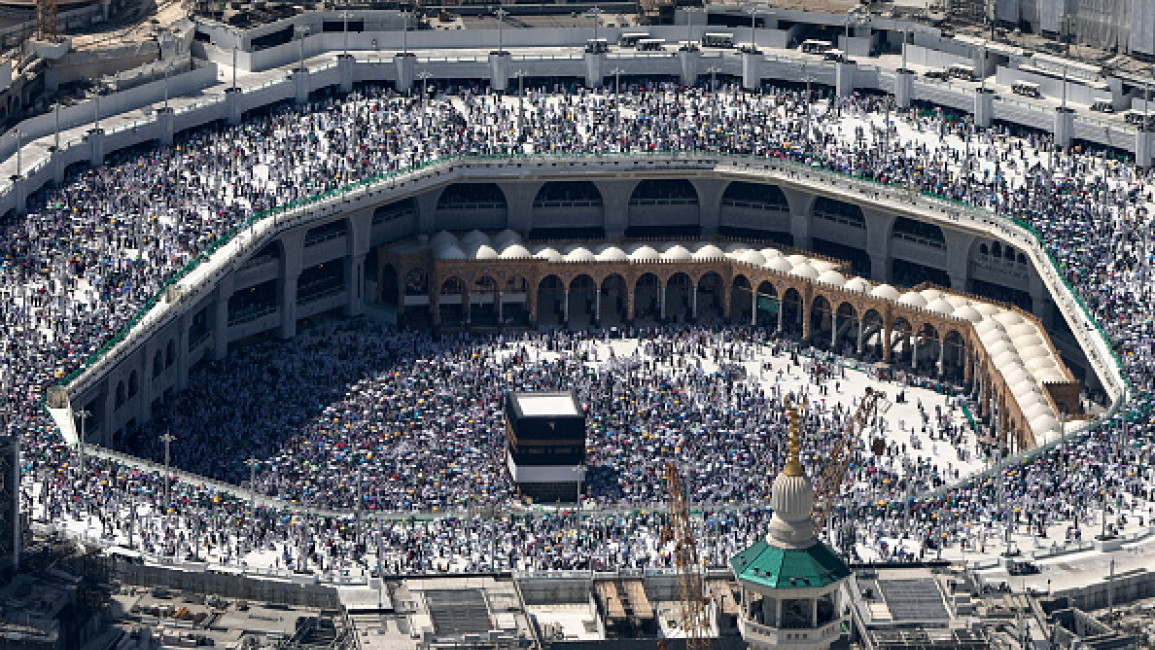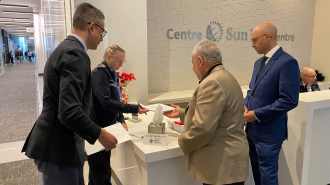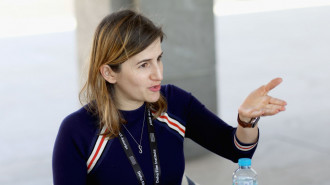
The Hajj heat disaster highlights the need for climate change action in Mecca

One after the other, the faces of missing pilgrims drop in the Telegram channel.
Nadia: a middle-aged woman cloaked in a white-preying veil. Samiyah: a smiling, gentle face wrapped in a pink hijab. Muhammad stands smiling inside a mosque, his shoulders wrapped in white cloth.
Below the pictures are their names, the place and date they were last seen, a phone number to contact, and sometimes, a plea to help.
"Thousands ended up in the hospital with symptoms of heat stroke and heat exhaustion, and hundreds died on the street"
The Telegram channel, named 'Disappeared at Hajj 1445' (after the Hijri calendar, which entered its 1445th year), had swelled to 4,000 members on the morning of June 21, most searching for loved ones.
The faces of these Egyptian pilgrims may never be seen again. All have gone missing over the past week while performing the Hajj pilgrimage, one of the five pillars of Islam.
For many practising Muslims, performing Hajj is a once-in-a-lifetime experience and a lifelong dream.
The pilgrimage draws over one million people to Saudi Arabia every year. After completing the Hajj pilgrimage, Muslims worldwide come together to celebrate Eid al-Adha.
But the dream turned into a nightmare for many this year – including the relatives of around 1,000 pilgrims who died while completing their Hajj under a ferocious heat.
Despite the extreme heat warning issued by the Saudi authorities last week, hundreds of thousands of people braved the sun as temperatures reached nearly 52 degrees Celsius in Mecca on Monday and 46 degrees in nearby Mina.
Thousands ended up in the hospital with symptoms of heat stroke and heat exhaustion, and hundreds died on the street, including pilgrims from India, Iran, Iraq and Jordan, and a staggering number of Egyptians, who make up around two-thirds of fatalities.
The toll could still rise in the coming days and thousands of families are still searching for their relatives.
Their messages have piled up in Facebook groups and Telegram channels over the past couple of days, alongside distressing photos, taken in the street, that show bodies lying on sidewalks under simple sheets.
Denied access to AC and locked out of mosques
According to multiple testimonies, the deaths were caused not only by heat but by poor management of the disaster by Saudi authorities.
Among these were various measures taken to limit access to air-conditioned housing and other amenities to “registered” pilgrims, leaving thousands of their “unregistered” counterparts without access to air conditioning.
“People were lying on the streets because they didn't have any camps to sit in the air conditioning, and the heat was unbearable,” Hesham*, an Egyptian pilgrim, told The New Arab from Mecca over the phone.
“It was like 48 degrees [Celsius] in the shade, and that's what may have caused many problems and deaths later on.
“Upon leaving Arafat, I saw one dead body,” Hesham said. “He was an elderly citizen. My friends told me that they also saw many people lying on the streets, all the way down to Mina.”
Like thousands of pilgrims from Egypt, Jordan and other countries neighbouring Saudi Arabia, Hesham attempted to perform Hajj without an official permit, which is issued each year by Saudi authorities through a system of national quotas, in a bid to control the huge crowds drawn to the Kingdom during Hajj.
"The movement of ambulances and paramedics was hindered and the number of those in need greatly exceeded the existing services"
Entering the Kingdom on a tourist, work or student visa instead, these unregistered pilgrims try to cut the cost of a pricy permit — which can cost up to $10,000 — undeterred by the threat of arrest, deportation and a possible travel ban to Mecca.
Unregistered pilgrimage has become more accessible since 2019, when Saudi Arabia introduced a general tourism visa.
Specialised agencies have also flourished online and in neighbouring countries to capitalise on these new pathways.
Saudi authorities have struggled to crack down against the practice, particularly this year when over two million pilgrims were expected, although they reportedly turned back over 250,000 unregistered pilgrims.
As unregistered pilgrims couldn’t access the air-conditioned camps and tents booked by registered ones, many slept outside with no respite from the relentless heat.
Some, like Hesham, sought shelter in air-conditioned mosques and were turned away. “I managed to get into a mosque before 4 am,” Hesham recalled.
“It was air-conditioned. But then I had to go to the toilet, so I left the mosque, but I couldn't get back in. Many people like me got locked out.”
Others, like Hesham’s wife, walked tens of kilometres under the scorching sun from one holy site to the next, unable to board the official Hajj buses made available to pilgrims — sometimes unwilling to seek help for fear of being detected.
Many suffered sun and heat strokes on the way, and some never made it to a hospital.
“The primary cause of death was sunstroke and heat stress, but also the large number of unregistered pilgrims. The movement of ambulances and paramedics was hindered and the number of those in need greatly exceeded the existing services,” Mostafa*, an unregistered Egyptian pilgrim who lost four of his neighbours during Hajj, told The New Arab on the phone from Mecca.
Managing the disaster
Due to the sheer size of the event, deaths are unfortunately recorded every year during the Hajj, often caused by simple exhaustion, accidents or crowd movements.
One of the deadliest to date was the year 2015 when over 2,000 pilgrims were killed in a stampede in Mina, leading Saudi authorities to adopt stricter crowd control measures.
This year’s disaster casts another ominous shadow on the future of the pilgrimage. Saudi authorities say they recorded more than 2,700 cases of “heat exhaustion” on Sunday alone, and thousands more the following day.
Heat exhaustion can occur when the human body fails to cool itself following sustained heat. It can lead to dehydration and heat stroke, which can kill quickly if not treated.
"The disaster also raises questions about who bears the brunt a climate disaster – in this case, “unregistered” pilgrims, who are often among the poorest"
Heat has long been a killer in the region, where heat-related health issues are estimated to kill 2 out of every 100,000 people on average.
That figure is expected to soar to 123 deaths out of every 100,000 people by the turn of the century due to climate change, which scientists warn will make swathes of the Middle East unlivable by the turn of the century.
The change is already felt in many places, including Saudi Arabia. According to a Saudi study published last month, temperatures around Mecca and Mina are rising by 0.4 degrees Celsius on average each decade, casting doubts about the future feasibility of the pilgrimage in the summer months.
Faced with these changes, Saudi Arabia faces an imperative to adapt: pilgrimages to Mecca are at once central to the way millions of believers practice their faith, and to the Saudi economy, generating $12 billion in revenues annually.
The 2024 Hajj disaster is not over yet but has already highlighted shortcomings in the way climate emergencies are managed, including pilgrims’ unequal access to cooling, which could arguably be considered a human right when temperatures hover around 50 degrees.
“It was very difficult this year, different than the last time I came, which was in 2019,” Hesham said.
“Lots of friends I know didn't know where to stay because all the hotels, of course, are booked and very expensive. And, everywhere where there was some shade, or trees or anything, it was overcrowded.”
The disaster also raises questions about who bears the brunt of a climate disaster – in this case, “unregistered” pilgrims, who are often among the poorest (although they also paid hundreds if not thousands of dollars to reach Mecca), were dealt the heaviest blow.
Yet there seems to be no straightforward way of making the Hajj safer as climate change intensifies: further restricting attendance seems difficult, and hardly fair to millions of pilgrims from poor countries who already struggle to afford an official permit.
It might also prove impossible, given the efforts believers are willing to make to get into Mecca.
“Egyptians really like to do the Hajj,” Hesham highlighted. “Some will do anything to get here: they can sell their property, they can sell their cars just to be here during pilgrimage because it's once in a lifetime.”
A disinformation storm
On social media, many observers seemed unaware of the connection between a warming climate and the widespread deaths recorded at the Hajj.
Facebook groups that provide pilgrims with advice and information on the Hajj are awash with photos of the dead, but many of those commenting believe that these deaths, while painful, were unavoidable or were simply part of a divine plan.
“Sometimes, people just die,” Abdelaziz*, a Saudi citizen living in Medina and working with a bus company providing transportation to pilgrims, told The New Arab over the phone.
“I have even seen pictures of people who just died in their hotels. You cannot even tell the reason if it was really from the heat or not (..) If they died from sickness, maybe it's just God's plan.”
Abdelaziz’ take found echoes on social media, where many pilgrims cast doubt on the impact of climate change on this year’s Hajj.
“All is in the hands of God”, or “Dying in Mecca is a blessing,” several members of a Francophone Facebook group wrote below one of these posts, along with prayers to the dead.
In a community of foreigners living in Saudi Arabia, others claimed that temperatures “are not unusual for this season”, with some arguing that “nothing significant happened at Hajj this year.”
The disbelief is compounded by the lack of communication from Saudi authorities on the official death toll, which was still unconfirmed as of June 21, and their causes.
“I don't think it's the correct numbers,” Abdelaziz said. “Until now, Saudi officials have not declared anything yet about people who died. It's only news on social media. You’re actually the first person to bring this to my attention.”
In a landscape rife with disinformation, accountability for these deaths – and better practices in the future — may be hard to come.
But Abdelaziz is hopeful: “Of course, our government will find a fast and clever solution. Hajj is bringing us a lot of money and business and we will not let it slide like this.
"People have been doing Hajj for hundreds of years, even before Prophet Muhammad was born, even before Islam, and have always gone and left safe.”
*Only the first names were kept, to protect the interviewees’ privacy
Lyse Mauvais is a freelance journalist based in Amman, Jordan. She covers environmental issues in the Middle East, with a focus on Syria and Jordan
Follow her on Twitter: @lyse_mauvais










 Follow the Middle East's top stories in English at The New Arab on Google News
Follow the Middle East's top stories in English at The New Arab on Google News


